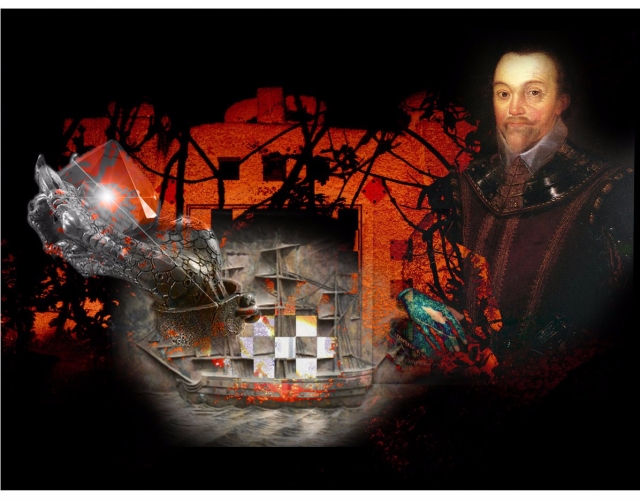 It is the beginning of May, 1587, and a man known locally as The Dragon is headed for Cadiz on Spain’s Atlantic coast. His mission is not peaceful. The act of sailing to Cadiz poses few challenges for this master mariner, who, ten years prior, had already circumnavigated the globe – becoming only the second person (after Magellan) to do so.
It is the beginning of May, 1587, and a man known locally as The Dragon is headed for Cadiz on Spain’s Atlantic coast. His mission is not peaceful. The act of sailing to Cadiz poses few challenges for this master mariner, who, ten years prior, had already circumnavigated the globe – becoming only the second person (after Magellan) to do so.
But what follows his arrival in Cadiz, at the head of a small fleet centred on four English galleons, is extraordinary by any measure…
In the sixteenth century, Spain is the mightiest empire in Europe–its wealth boosted by gold plundered from the New World… It is also considered the fiercest defender of the Catholic faith; a faith under threat from the growth of Protestantism in Northern Europe, including its foremost enemy: England.
Phillip II has the Pope’s blessing to invade and subdue England, using whatever means is necessary. The Queen of England, Elizabeth I, has been excommunicated by the Pope and King Phillip is assembling a fleet of over a hundred ships to solve the ‘English problem’. English sailors, regarded as little more than pirates by the Spanish, have been a thorn in its side at home and abroad, especially in the New World, where British Privateers have been particularly effective in plundering the gold that Spain has so carefully extracted from the natives.
The man commanding the small fleet now sailing into Cadiz harbour is Sir Francis Drake. The Spanish hate and fear him so much, they have named him El Draque – the Dragon. History will record that he was here to ‘singe the King of Spain’s beard’.
The tiny English fleet – sent by Elizabeth to begin a preemptive action against the gathering might of the Spanish Armada – will spend the next few days in two key Spanish ports (the other being Corunna) destroying a total of thirty-seven of Phillip II’s best ships, despite adverse weather and constant shelling from the guns on the cliffs. Seldom had there been such a display of seamanship, against such difficult conditions.
The success of the raid will delay the Armada by a full year. More significantly, the cargoes plundered by Drake in Cadiz turn out to be well-seasoned timber staves essential for the construction of wooden barrels for food and water storage. When the Armada finally sails, in the summer of 1588, one of the contributing factors in its failure will be the poor storage of supplies and consequent ill-health of the sailors in the Spanish fleet… Of such small details are vast changes in sovereign fortunes made…
The Spanish considered the raid on Cadiz so audacious that Phillip, himself, sent an urgent letter to the Duke of Medina Sidonia, the commander-in-chief of the Spanish Armada, warning him of the other likely targets of El Draque’s murderous voyage (below).
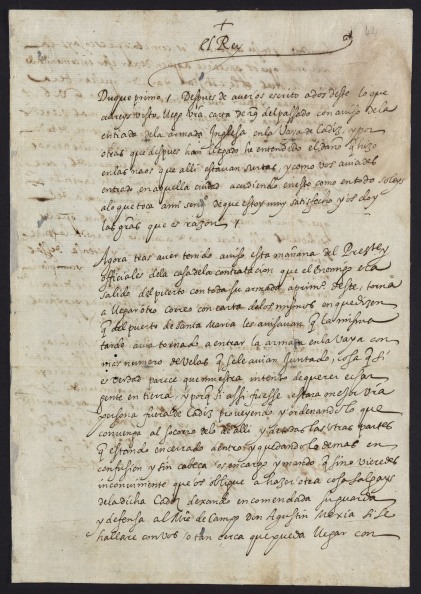
Phillip II’s letter to the Duke of Medina Sidonia warning of Drake’s likely next targets. A rare example of a document that backs up an audacious legend (source)
Nowadays, we are acutely aware of historical exaggeration and propaganda, but this letter is a rare piece of factual evidence that proves how infamous Drake actually was; not that he was shy at promoting his own image…
Francis Drake was born in Tavistock, West Devon, in 1540, seven years after his future queen. He was the eldest of the twelve sons of Edmund Drake, a Protestant farmer. In 1549, the family had to flee local religious persecution and re-settled in Kent, where the resourceful Edmund secured religious training and a position as Deacon of Upnor Church on the Medway, a busy part of the Thames estuary. From Upnor, he was able to minister to the men in the King’s Navy – a first contact upon which he was able to build his, and his children’s, future.
Drake was apprenticed to the master of a barque used to ship merchandise from London to France. Drake’s work pleased the owner of the vessel so much that the childless ship’s master bequeathed the boat to Drake on his death.
The family already had naval connections, and the sea was to shape his life from this point onwards. John Hawkins, later Sir John Hawkins, was Drake’s second cousin and, following the younger man’s successful apprenticeship, he was taken into the extended family’s shipping business, based in Plymouth. In 1563, aged twenty-three, Drake made his first voyage to the Americas, under the command of his cousin. Three more voyages followed, during which the English ships attacked Portuguese towns and ships on the West African coast. Hawkins has a dark reputation as the first English slave-trader, and inducted the young Drake into the trade. The captured cargoes of slaves were, ironically, sold to Spanish plantations…
On the third such voyage, the Hawkins fleet, undergoing resupply and repair in Mexico, was attacked by Spanish warships. Only two of the family ships survived. Drake and his cousin only escaped by swimming to safety. This incident, combined with the persecution of his childhood, set Drake on a course against Catholic Spain, a course he would pursue with delight and skill as his fortunes unfolded.
The coast of Panama was used as a staging post for the Spanish treasure-gatherers, and Drake polished his privateering skills along its coast, taking considerable riches from the raids. He seemed both skilful and lucky in his exploits, but was severely wounded on more than one occasion.
On Elizabeth’s secret instructions, Drake went on to circumnavigate the world, sailing around Cape Horn and entering the Pacific, where he claimed California for the English Crown. The voyage of exploration was punctuated with several acts of plunder on Spanish ships and ports, and, in 1580, with only one ship (The Golden Hind) remaining, he returned to England with a full cargo of treasures, including an exotic jewel made of enamelled gold and bearing a diamond and an ebony ship, which he presented to Queen Elizabeth.
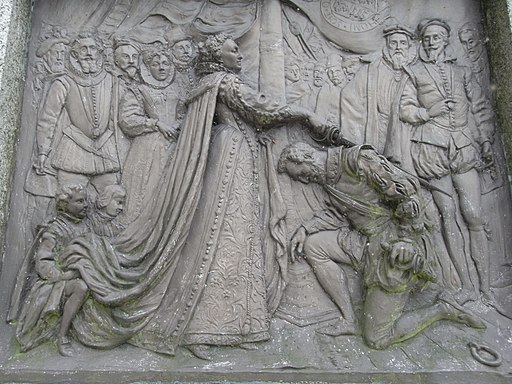
Drake is knighted by Elizabeth I. The monument to Drake in Tavistock. Wikipedia public domain. Source.
The Queen delighted in his successes against the Spanish, and knighted him aboard the Golden Hind in 1581 – an act that enraged Phillip II of Spain. On William Cecil’s advice, all the records of the voyage were made state secrets, and the remaining crew were sworn to secrecy. Everyone knew that war with the Spanish would be forthcoming, but with men like Drake at her side, Elizabeth felt that the spirit of her England had a chance of success.
Drake was a commoner and had risen to be one of Elizabeth’s favourites; quite an achievement. For his coat of arms he adopted a shield showing two stars; representing the Arctic and Antarctic, connected by the oceans, topped by an image of the Golden Hind. The Hand of God is shown as benevolent fate within his lifetime, indicating, with appropriate humility, that his good fortune was not wholly his own doing.
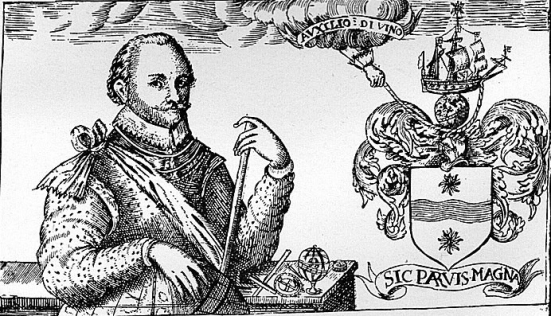
The Coat of Arms adopted by Sir Francis Drake
The year after the raid on Cadiz, one hundred and twenty Spanish ships set sail to invade Elizabeth’s England. Drake was second in command of the outnumbered English fleet, which was led by Lord Charles Howard. There is no historical evidence that Drake delayed his departure for battle while he finished his game of bowls in Plymouth. The apocryphal story appeared some thirty years later and fits with our heroic and stylish picture of the man, so it lives on in the imagination.
The result is well-known. A combination of inspired seamanship by Drake and Howard, plus adverse weather, saw the invasion flounder. What is less well known is that two-thirds of the ships returned safely to Spain, having circumnavigated the British Isles, pursued by an English fleet that was unable to inflict too much harm. The greatest damage was to Phillip II’s reputation. His life had been intertwined with England’s queens since his earlier marriage to Queen Mary – Catherine of Aragon’s daughter. In his journals he claimed to have influenced Mary to restore Elizabeth to the royal line of succession.
We may never know the truth of this; if so, it is doubly ironic that the bravery of Elizabeth and her senior officers brought about the decline in respect for Phillip, and he never recovered.
Although Drake’s place in the heart of England was secure. His military fortunes declined, and the English Armada ordered by Queen Elizabeth I, fared no better than had the Spanish fleet.
Sir Francis Drake died in Panama on the 28 January 1596 of dysentery. His last unsuccessful expedition was with his cousin, Sir John Hawkins. They died together and their bodies were buried at sea. Drake had asked to be dressed in his armour for his death, and had already made provision that his body be placed in a lead coffin before it was committed to the deep.
How does all this relate to our mystical workshop in April 2018 – The Jewel in the Claw?
Sir Francis Drake is an obvious heroic archetype to use in a mystical play like this. But his life illustrated far deeper issues that were at the heart of Elizabeth’s England. Heroes operate within a theatre of circumstances and responses in which there are few freedoms. Only by being unafraid of being alone, could Elizabeth release the potential of her age. Drake, along with Raleigh, was one of her most visible heroes, but there were many others – men like William Cecil, who moved with equal precision behind the scenes. Nor can the age’s ‘scientists’ like Dr John Dee – at the centre of our story – be considered to be any less heroic in their world of knowledge rather than action.
In our mystical drama, Sir Francis Drake is one of Elizabeth’s appointed champions. But, he has a more difficult and deeper layer to his role within her ‘court’. His depth of experience lends his character special skills when it comes to understanding the motives of men… and women.
In our story, when the company arrives at NonSuch palace, they are shown into a newly-prepared room, one in which a deadly search for the truths of the age will be played out on many levels: intellectual, emotional, religious and magical. Outside of the Queen’s own mind, no-one else in the room is aware of what is to follow.
What confronts the participants in the centre of the space is a huge game board consisting of black and white squares…
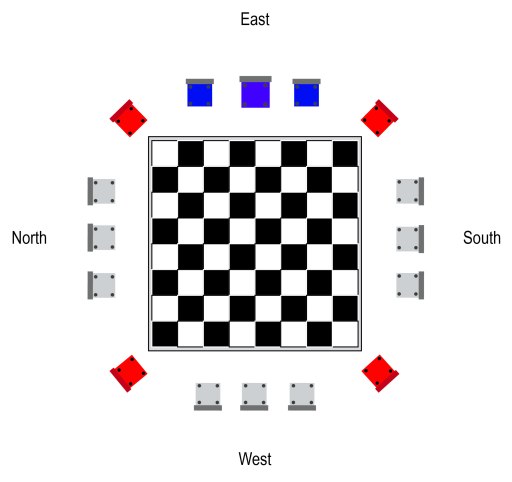
Each side of the board has its own symbolism and its own champion. In our five-act magical drama, Drake has a very special relationship with the Queen, one in which his grasp of the importance of Naval warfare can be used to royal advantage…
The Silent Eye’s spring workshop, April 2018 is: “The Jewel in the Claw’. The jewel is the emerging spirit of humanism and tolerance that Elizabeth, the self-styled virgin-queen, engendered; the claw is the nature of the forces of ignorance that still plague us in the twenty-first century every bit as much as they did in 1588, the year that the mighty Spanish Armada was defeated by a combination of English naval courage and our equally fabled weather; and Elizabeth I finally achieved a degree of security.
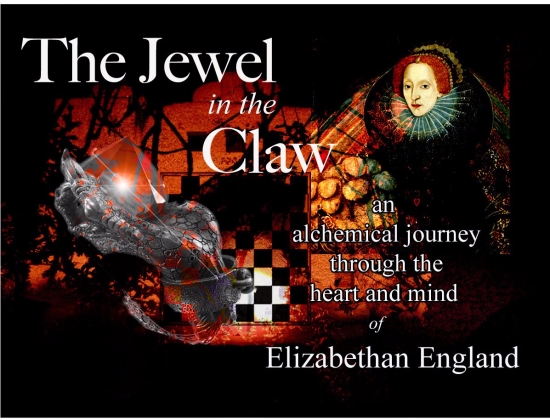
The Silent Eye has produced dramatic mystical workshops since its inception in 2013, but this is a break from tradition, and will stick closely to the formula of an actual Elizabethan production, letting the acts of the play tell the deeper story. There is no formal audience, of course. We, the players, play to each other, and in doing so invoke the desired depth of psychological and spiritual interaction.
If you’ve never been to such an event before, don’t be over-faced by this heady agenda. There are always new people joining us, and we take great care to ensure they are comfortable. We do not expect our ‘actors’ to learn their lines! We all read from scripts – as though doing a final rehearsal, but the atmosphere is truly electric and you will find yourself working to bring your character to the greatest life you can give them! You will also find they stay with you for years afterwards…
Above all else it is always fun; and every year, come the Sunday farewell lunch, those attending do not want to go home and end that living link with a body of experience and aspiration that they have helped create…
We can honestly say that the workshops become a living thing, formed and sustained in the minds and hearts of those attending. Come and join our ‘merry band’ and you’ll want to come back.
Places are still available for ‘The Jewel in the Claw’. 20-22 April, 2018. The average price is approximately £250, fully inclusive of all meals and accommodation. You will struggle to find a better value weekend, anywhere.
The weekend workshop will be held at the lovely Nightingale Centre, Great Hucklow, near Buxton, in the heart of the Derbyshire Dales at a wonderful time of year – the spring.
You can download the pricing and booking form here:
Other posts in this series cover:
John Dee, Sir Walter Raleigh, Sir Philip Sidney
Robert Dudley, Earl of Leicester
For more information email us on rivingtide@gmail.com
Banner Image: Composite of original artwork by the author plus a portrait of Sir Francis Drake, courtesy of Wikipedia, CC by 3.0, Public Domain.
Images in background montages by the author – own photography.
Underlying images:
Sir Francis Drake Wikipedia Commons – public domain. source.
Underlying image of plaque of ship CC BY-SA 3.0 source
Stephen Tanham is a director of the Silent Eye School of Consciousness, a not-for-profit organisation that helps people find the reality and essence of their existence via low-cost supervised correspondence courses.
His personal blog, Sun in Gemini, is at stevetanham.wordpress.com
©️Stephen Tanham.

A fascinating story.
Last year I visited the viceregal residence of Christopher Columbus’s son in Santo Domingo, capital of the Dominican Republic. The guides there have long memories and still refer to ‘the pirate Francis Drake’.
Thoroughly deserved, I suspect…
what an amazing story
He was a true adventurer, and the Queen needed them!
Thank you, Sue x
A very interesting post, Steve. I did know some of this about Drake but not all of this interesting detail.
Thank you, Robbie. A fascinating adventurer.
Reblogged this on Stuart France.
A Thoroughly Enjoyable article Steve. Fascinating! Love that you guys are employing modern versions of ancient liturgical dramas rich in myth and meaning… as in the best mystery schools!
Thank you, Paul. We’re trying!
Reblogged this on Have We Had Help? and commented:
Remembering Drake…
Thank you, Jack.
It’s an illuminating article Steve which helped me to fill in the gaps when it comes to Drake, Thank you…
I’m delighted it did that.
Wonderful post! As a person who likes to sail, Sir Francis has long been a favorite historical figure of mine.
Thank you, Noelle, my father taught me to sail in my teens on Ullswater. I’ve had an affinity with sail ever since, though we don’t have a boat, now.